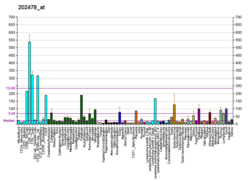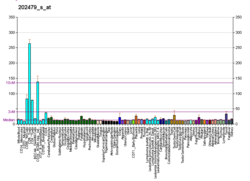| TRIB2 | |||||||||||||||||||||||||||||||||||||||||||||||||||
|---|---|---|---|---|---|---|---|---|---|---|---|---|---|---|---|---|---|---|---|---|---|---|---|---|---|---|---|---|---|---|---|---|---|---|---|---|---|---|---|---|---|---|---|---|---|---|---|---|---|---|---|
| Identifiers | |||||||||||||||||||||||||||||||||||||||||||||||||||
| Aliases | TRIB2 , C5FW, GS3955, TRB2, tribbles pseudokinase 2 | ||||||||||||||||||||||||||||||||||||||||||||||||||
| External IDs | OMIM: 609462; MGI: 2145021; HomoloGene: 41445; GeneCards: TRIB2; OMA:TRIB2 - orthologs | ||||||||||||||||||||||||||||||||||||||||||||||||||
| |||||||||||||||||||||||||||||||||||||||||||||||||||
| |||||||||||||||||||||||||||||||||||||||||||||||||||
| |||||||||||||||||||||||||||||||||||||||||||||||||||
| |||||||||||||||||||||||||||||||||||||||||||||||||||
| |||||||||||||||||||||||||||||||||||||||||||||||||||
| Wikidata | |||||||||||||||||||||||||||||||||||||||||||||||||||
| |||||||||||||||||||||||||||||||||||||||||||||||||||
Tribbles homolog 2 is an atypical protein kinase that is encoded in human by the TRIB2 gene. [5] [6] [7] [8] TRIB2 is a pseudokinase member of the (pseudoenzyme) class of signaling/scaffold proteins, possessing very low vestigial catalytic output in vitro and critical scaffolding signaling functions in cells. [9] It is known to signal to canonical MAPK and AKT pathways and to regulate the ubiquitination of substrates with important functions in cell proliferation that control the cell cycle. It has also been associated with various diseases, especially in human and murine blood and solid tumor models. [10] Like TRIB1 and TRIB3, TRIB2 has recently been considered as a potential allosteric drug target, [11] and its three dimensional structure has been solved with the aid of stabilizing nanobodies [12] corroborating the potential for new approaches for drug targeting outside the highly degraded ATP site [13] and is a putative regulator of cancer-associated signalling and survival through AKT pSer473 modulation. [14] Recent work has established a convincing link between targetable overexpression of TRIB2 and prostate cancer drug responses [15]





